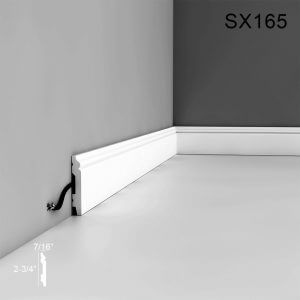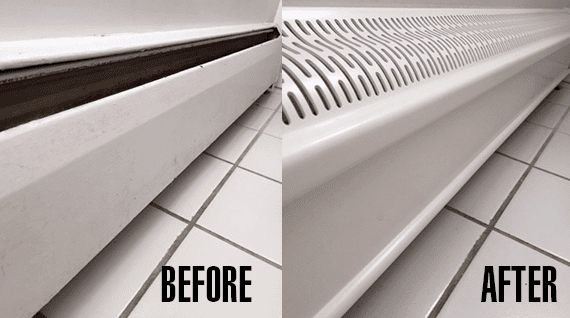There are so many paintbrushes out there that you can use for your cutting in, trim work, and on baseboards.
However, only a few can actually help you get the job done without a whole lot of mistakes. One of the best paint brushes for baseboards that are making the wave on the market is the Proform Angle Sash Paint Brush.
If you’re in the business of moving paint, especially if you regularly deal with intricate areas of the home like the baseboard, you need something that can deliver in quality and application.
The Proform Angle Sash Paint Brush features a well thought out design that makes it easy to lay down thick or thin paints.
Though it’s 2.5 inches in size, it carries a capacity of 3 inches baseboard brushes – and can be considered to be in the league of the Wooster Alpha Brush.
It gives you a very good hold and has a knack for the swift release of paint in one non-stop pass. Although it wears out faster than competing brands, the cost of replacing it every few weeks is negligible.
And if you’ve not used anything like an angle sash paintbrush before, you have some getting used to when working with the brush.
However, when it comes to working with baseboards – where there is no room for making mistakes as little as a single mark on the wall – you need something that can make your life easier.
Fortunately, the Proform Angle Sash Brush is both an artist brush/production brush that gives you good application and a nice finish.
If you are looking for a brush that helps you cut sharp, solid lines farther than you can reach along with your baseboards, you should check out the Proform Angle Sash Paint Brush.
Some of the links below are affiliate links, meaning, at no additional cost to you, we may make a commission if you click through and make a purchase.
Table of Contents
How to Choose the Best Paint Brush for Baseboards

You can have the best quality paint but if you use the wrong brush, you’re going to waste time and money. By investing in the right tools, you’re guaranteed to get a better result.
Generally, there are two types of paint brushes, natural and synthetic. Natural brushes are sued with oil-based paints.
Water-based paints, on the other hand, are best applied with synthetic bristles like nylon or polyester. Synthetic bristles hold their shape and maintain stiffness no matter how much water they’re exposed to.
A top quality polyester brush is well worth the initial cost when cleaned and stored properly. It’ll keep painting smoothly for years to come.
You also have to choose a brush size and shape. Smaller angled brushes are great for cutting and trim works whereas a flat brush is good for molding.
Choose a slightly larger brush when painting corners and when you’re painting a really large surface, go ahead and get the biggest brush you can get.
When it comes to painting, there is the technique and then there’s the tool, which we all know is a paintbrush. If you’ve ever walked the aisles of the home center, you also know that there are a lot of paintbrushes on the shelves.
To help you pick the right brush, here are a few tips for you to consider when buying a paintbrush.
- Tug on the bristles. If one or two of them come out, the brush is probably not worth buying
- Hold the brush by the handle and make sure it feels comfortable in your hands. Remember, you are going to be working with this brush all day.
The next thing you should think about is what brush is suitable for your project? It depends on what you’re painting with.
Paint Brush for Oil-Based Paint
There’s an oil-based paint and there’s also water-based paints. For oil-based paints, it’s better to use a Chinese bristle brush. This is because it’s a natural bristle and is actually animal hair.
Why this kind of brush for oil-based paint? Because they’re very soft and tend to be a little bit stiffer than synthetic brushes.
They can push the heavy bodied oil paints versus the lighter weight water-based paints. So with this brush, you can move them around on whatever surface you’re painting and apply a nice uniform coat without too much problem.
Now, if you ever use this in a water-based paint, you’ll ruin the brush – yes, it will get destroyed. The bristle will absorb the water and expand and it basically becomes a dust brush.
Paint Brush for Water-Based Paint
What about the brush to use for water-based paints? Generally, for water-based paints, you should use a synthetic brush that’s made out of nylon and polyester.
They don’t absorb the paint. The paint tends to collect between the bristles so they have to machine distress the brush so that it delivers the paint in the same fashion as a Chinese bristle brush in a nice uniform coat.
You can actually use this for oil-based paint as well. The only problem is that it’s a little bit softer than the Chinese bristle.
There are some new models that usually have synthetic fiber with a little bit of stiffness to it like the Chinese bristles, so it should be easy to make your choice.
What Makes a Good Baseboard Brush?

What are the things that go into a good brush and a cheaper brush that makes them different? What are the features you should look for when choosing a paintbrush for baseboards?
First, the construction of the brush is very important. When selecting a good quality brush, you want to ensure the handle is made from wood and avoid those brushes with plastic handle even though they are cheap.
Usually, a brush with a plastic handle may loosen up and fall off your hands while painting. Another thing to look out for is a brush with a well-fixed ferrule and good quality bristle.
If you are buying in the store, you can feel the tip – it should feel nice and soft – as that’s the part that’s going to be applying the paint. The tip should be able to release the paint in an even fashion.
The other thing to watch out for is the number of bristles on the brush. Cheaper brushes tend to have fewer brushes and sometimes are not strong enough that they drop into the paint, creating a mess at the end of the day.
Another important thing to consider when buying a brush is the cost. If your goal is to buy a quality paintbrush, you may have to pay a little extra.
How much extra are you going to pay for a good brush versus a cheap brush? Probably about twice as much.
The last thing you want to consider is the shape of the brush. The square cut and the angle cut types of brushes are probably the most common.
If you are painting a very big surface, it’s better to go for a square cut. For example, if you are painting baseboards on a house barn board, you want something that you can go back and forth with while applying paint.
The angle brush tends to be used for more detailed-oriented things like windows and trims. If you have to get into corners where you want to have a nice careful line, you need a brush that can give you measurable control.
So the angle brush gives you a lot more control than the square shaped in this case.
YOU CAN ALSO READ: The Best Paint Brush for Trim
Best Way to Paint Baseboards
Before you start painting your baseboard, go and get the Proform Angle Sash Paint Brush.
Can you paint baseboards? Yes, you can, even if you’re not a professional. And in this section of this guide, you’ll learn how to paint your baseboards.
Here:
Let’s face it, getting down on the floor to paint baseboards and moldings doesn’t sound like much fun, does it? But there are some steps that you can take that will make this job easier.
Step By Step Guide on How to Paint Baseboards
Step 1:
First, wipe the baseboard with a damp cloth, remove dust and dirt. If you have a good, steady hand, you may choose to cut in the baseboard and trim.
If you’re not experienced, then put painters tape on the wall just above the baseboard to help avoid getting paint on the wall.
Now, painters tape comes in a variety of sizes and you may want to use a wider tape if you’re concerned about paint on the wall. You can also use painters tape around the doorway and top edge of the door.
Step 2:
If you’ve already prepared the floor for painting with a drop cloth and tape, then both your wall and floor should be protected while you paint the baseboards.
The size of the brush needed will be determined by the size and type of trim. Usually, 2 ½ angle sash brush like the Proform Angle Sash Paint Brush will do a great job.
If you’re using latex paint, a good quality nylon or Paulino line brush should work well. But if you’re using cut out paint, go for a natural bristle brush like the Proform.
Step 3:
The best place to start painting is in the corner and then work your way around the room. Carefully paint in a nice, straight line and make sure your paint strokes follow the length of the baseboard rather than going up and down.
Step 4:
Once you have completed the painting and the paint is set to touch, you should remove the painter’s tape.
I recommend using a sheen that’s higher in gloss than what’s on the walls as this will showcase your molding separating, separating the walls from the trim.
However, that’s a personal choice.
Related: Best Paint Roller for Walls
Cleaning and Maintaining Your Paintbrushes
Before you start cleaning, make sure you get as much paint out of the brush as much as you can. It’s a good idea to just brush it out on a piece of crap just to get all the residual liquid paint off the bristles.
After that, you can do a good rinse of the brush and use your thumb to squeeze out any residual paint. If there is dried paint on the brush, you can use a brush comb to get them loosen up.
Don’t use a wire brush because it’s too aggressive for a paintbrush. It’s going to scratch the ferrule and render the brush ineffective for your next project.
The final stage in cleaning your brush is to use clean water to wash it. Take a bucket of water and spin the brush inside.
You can use warm water to clean out the ferrule and rinse the brush until you’re sure the brush if fully cleaned.
Related: Best Paint Brush for Trim
Final Words on the Best Paint Brush for Baseboards
There you have it. You’re a now one step ahead people who are trying to paint their baseboards with the right brush.
Although there are many models out there, following this guide ensures you get the right tool for the job which means you make mistakes less often.
Read this carefully, digest it, and you should be on your way to selecting the best paint brush for baseboards.
